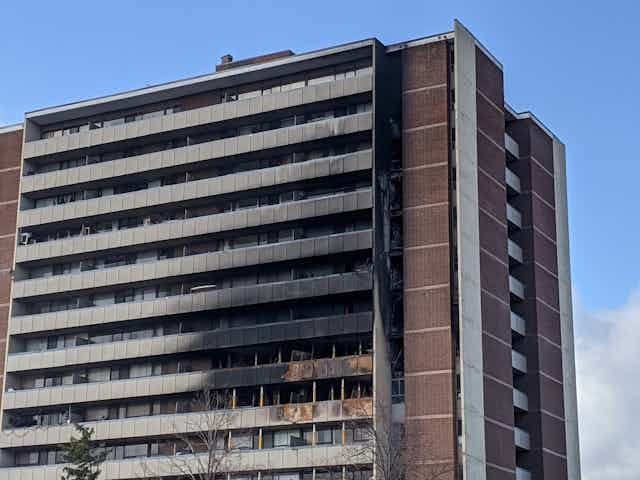On the evening of Nov. 15, 2019, the Toronto Fire Service responded to a five-alarm fire at a 15-storey apartment building located in the northwest part of the city at 235 Gosford Boulevard.
The fire killed one resident, injured six and displaced hundreds. While it was initially reported that up to 700 people were left homeless, Toronto Emergency Management Authorities reported that approximately 354 people have been displaced.
Urban fires
Unfortunately, Toronto is again coping with the complex aftermath of a common urban disaster — fires occurring in large tower block apartment buildings. In large cities, fires are an everyday occurrence. In 2018, the Toronto Fire Service responded to 181,928 fires.
November and December are considered peak months for fire-related deaths. This is due to holiday-related cooking accidents and an increased need for indoor heating with colder weather.
A majority of fire emergencies are disastrous for the individuals and households involved. These emergencies can be aptly handled by standing first responders and existing social service programs like the Canadian Red Cross’s programs to assist after a fire. But on occasion, these high-rise fires expand from everyday emergencies into full-blown disasters. The disaster-like characteristics of such fires multiply when they occur at densely populated high-rise tower blocks and in areas of the city that are already socially and economically distressed.
The Black Creek neighbourhood
The Gosford fire occurred in Toronto’s Black Creek neighbourhood, an already distressed area. Census data indicates the neighbourhood has a population of 21,737: 55 per cent of residents live in apartment buildings of five storeys or greater (compared to 44 per cent for Toronto). Sixty-seven per cent are renters (compared to 47 per cent for the city). Visible minorities make up 81 per cent of the neighbourhood (compared to 52 per cent for the city), and the poverty rate is 34 per cent compared to the rest of the city at 22 per cent.
In a 2014 report, the neighbourhood was considered Toronto’s least liveable. Black Creek received Toronto’s lowest score on a Neighbourhood Equity Score index — 21.38 on a scale of zero to 100. Despite the challenges faced, residents suggest that the neighbourhood’s diversity is its strength and it does not deserve the negative reputation it sometimes receives.
Sudden displacement
The Gosford fire has displaced two to three per cent of the Black Creek neighbourhood on a sudden-onset and unexpected basis. It is not known when the displaced residents will be able to return to their homes in the high-rise building. Many affected families have been thrust into precarious lodging and financial situations.
The disaster response has ranged from the deployment of city buses for immediate respite sheltering to the establishment of reception centre and mass shelter operation at York University. The City of Toronto is responsible for the shelter, the Canadian Red Cross provides for day-to-day operation of the shelter and York University has provided the space for mass sheltering. A week after the fire, approximately 45 people are living at the re-purposed athletic centre, and the length of their stay may be weeks.
The scope of this disaster has expanded to the point where it is expected that long-term provision of emergency social services will be needed. An appeal for more community help has been issued by residents.
At worst, the Gosford fire will deal a blow to individuals and the community that cannot be overcome. A neighborhood becomes increasingly distressed, residents with stable livelihoods are thrown into long-term disarray and precarious residents fall through the cracks.
Open questions ranging from the short-term decisions of when and how to phase out the mass sheltering operation to long-term questions related to best meeting the transitional housing needs of those persons displaced (in an already tight and expensive rental housing market) can all become messy.
Problems include dozens of traumatized persons needing to regain a sense of safety, the real possibility that the aid provided may fall short and the fact that some people may not have renter’s insurance. In the end, who pays for it all? Then the lawsuits begin.
Ongoing displacement
In August 2018, another Toronto high-rise apartment fire at 650 Parliament Street displaced 1,500 persons. More than a year later, persons displaced from that fire remain out of their homes with their lives on hold. Normalcy has not yet returned to displaced residents and challenges such as instability with children, mobility and health problems exist.
On the other hand, community stakeholders may come together to help their neighbours through this emergency. Disasters can provide opportunities for people to come together and help each other.

The fire dealt a severe blow to the Black Creek neighbourhood, but it is not something that is unprecedented for large cities. In the much more devastating 2017 high-rise fire at London’s Grenfell Tower that killed 72 residents, examples of community resiliency emerged.
There are numerous signs of hope in Toronto. For the first time in its history, York University made shelter space available. The Toronto District School Board has launched a relief fund for families affected by the Gosford fire. And while the disaster of the Gosford fire presents many challenges, it is hoped that resiliency will prevail over distress and desolation.

